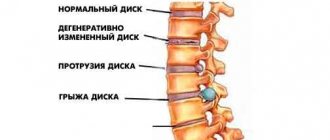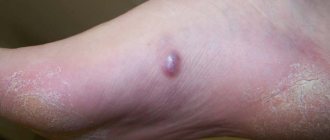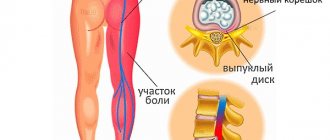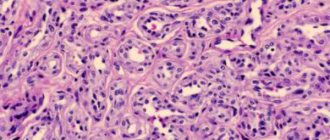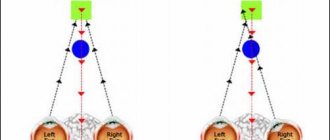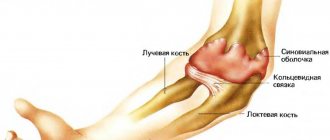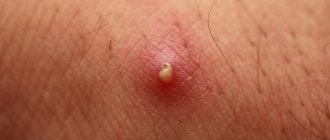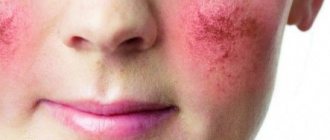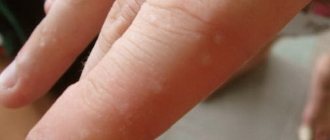Carbuncle - causes
The main cause of carbuncle is the penetration of pyogenic microbes, in particular, Staphylococcus aureus and other types of Staphylococcus, Streptococcus, Escherichia coli, non-clostridial anaerobes, Proteus and others under the top layer of the skin.
The following factors can contribute to infection getting under the skin:
- Exogenous – violation of the integrity of the skin (friction of clothing, wounds, abrasions, cuts, scratching, squeezing pimples), increased environmental pollution, failure to comply with personal hygiene rules;
- Endogenous - internal infections, increased sebum secretion, increased oily skin.
In addition, local or general weakening of the body also plays a large role in the development of carbuncle.
The reason for the decrease in the body’s protective functions can be:
- Hypothermia of the body;
- Physical exhaustion of the body;
- Constant stress;
- Insufficiency of vitamins and microelements in the body (hypovitaminosis, vitamin deficiency);
- Various diseases that weaken the immune system - acute respiratory infections, diabetes mellitus, HIV infection, metabolic disorders, obesity, malignant diseases;
- Diseases of the liver, kidneys and digestive organs;
- Alcohol abuse, smoking, uncontrolled use of certain medications.
Favorable conditions for the development of carbuncles develop when:
- failure to comply with hygiene rules;
- increased secretion of the sebaceous glands;
- increased sweating;
- skin contamination with particles of sand, lime, coal, cement, oils and petroleum products;
- excess air humidity;
- damage to the skin (after insect bites, squeezing out pimples);
- high air temperature.
Most often, carbuncles develop in people who:
- suffer from diabetes;
- has more than 10% excess weight;
- suffered a serious illness;
- significantly exhausted;
- are anemic;
- suffer from overwork of a neuropsychic nature.
The basic reason for the formation of a carbuncle, a purulent-necrotic process, is the penetration of pathological microorganisms into the skin (streptococci, Escherichia, staphylococci, enterococci and protozoa). Factors that contribute to this process:
- the presence of small cracks and other damage on the skin that are difficult to notice with the naked eye;
- violation of personal hygiene rules;
- increased work of sweat glands;
- anemia (anemia);
- excess weight;
- diabetes;
- previous severe infectious diseases;
- surgical interventions;
- high temperatures of the external environment;
- prolonged stress factors;
- mental disorders.
The carbuncle is formed due to infection - staphylococci or streptococci entering the body. But at the same time, there are a number of factors that provoke the development of the disease, namely:
- Skin damage. Even a minor scratch can cause the pathogen to become active. Such an irritant can be an insect bite (and subsequent scratching of the bite site), a pimple that has been squeezed out, or coarse dust (lime or coal).
- Poor skin hygiene. These are diaper rash and the consequences of sweating, contact with substances that irritate the skin (machine oil, fuel oil, etc.), neglect of personal hygiene rules, and high humidity.
- Poor nutrition. A lack of vitamins and minerals in the body can provoke the development of a carbuncle.
- Certain diseases. For example, diabetes mellitus, the consequence of which is metabolic disorders. Exhaustion of the body, which occurs as a result of nervous fatigue or anemia, is also one of the reasons causing the appearance of a carbuncle.
As it became clear, the reasons for the appearance of a carbuncle can be basic and concomitant. They determine the development of not only carbuncles, but also other skin diseases, for example, boils.
The carbuncle mainly forms in the back of the neck; it is this area of skin that is constantly rubbed by the collar. In some cases, a carbuncle may appear on the face: lips or cheeks. Facial carbuncles most often affect young people, and in older people the carbuncle is fixed on the neck, back or buttocks.
In the vast majority of cases, the causative agent of the carbuncle is Staphylococcus aureus. Less commonly, inflammation develops due to streptococcus, enterococcus, Escherichia coli or anthrax bacteria. A favorable factor for the onset of the disease is a decrease in the body's resistance to various infections.
The following factors can also contribute to the formation of pathology:
- exhaustion of the body due to constant diets;
- anemia;
- increased activity of sweat and sebaceous glands;
- non-compliance with personal hygiene (untimely change of bed linen, clothes);
- increased air humidity;
- endocrine diseases;
- constant contact with petroleum products.
Improper squeezing of a pimple can cause the development of a carbuncle.
A carbuncle may appear due to an improperly squeezed pimple. A small purulent inflammation will rapidly increase if it is not treated correctly. The situation is aggravated by the patient’s reduced immunity. The body's defenses cannot resist the multiplying infection.
The etiology of the origin of this purulent abscess is most often bacterial. It is Staphylococcus aureus that usually causes the formation of carbuncles.
Other reasons:
- streptococci;
- coli;
- enterococci.
Carbunculosis affects people with low immunity, diabetes, overweight, dysfunction of the gastrointestinal tract, liver and kidneys, as well as vitamin deficiency.
Provoking factors in the development of this disease are stress, overwork, working in a dusty room or in a building with high humidity and air temperature. Unsanitary conditions, dust, contact with petroleum products, and poor body hygiene lead to the worsening of a disease such as carbuncle.
You need to be careful when squeezing pimples. Wounds are a favorable environment for infection and the development of the inflammatory process.
The frequent appearance of carbuncles is a consequence of the simultaneous influence of several unfavorable factors, for example, sweat, saws and clothing friction.
A carbuncle can become a complication of untimely treatment of a boil. As a result, vascular thrombosis occurs in the area of the abscess; not only the skin, but also the subcutaneous tissue is subject to necrosis. The area of skin in the center becomes black (this indicates necrosis).
Historical data
burning ember
The word "carbuncle" is hopelessly outdated these days. Nowadays it is almost never used. Previously, this was the name given to any red precious (or semi-precious) stones. Most often these were various grenades.
Carbunculus means “coal” in Latin. The name so expressively reflects the appearance of the stone, which when illuminated by the sun becomes like a burning coal. The ancient Greeks gave it its own name "anfrax". This word is considered even more outdated than carbuncle. This is what is mentioned in the Bible.
Reliable source
In 1891, the rector of the Vysokopetrovsky Monastery, the spiritual writer Archimandrite Nikifor, completed the work of creating the “Illustrated Complete Popular Biblical Encyclopedia.” In this book, the priest explains the section of the Bible on mineralogy, which talks about a rare gemstone that was brought from Peru.
He writes that the stone is dark red in color, but in the sun it becomes like a burning coal. It is also noted there that in the robe of the high priest, the anfrax-carbuncle is located in the second row of the breastplate (quadrangular breastplate).
This fact confirms that people knew this red mineral at the dawn of civilizations.
Stone from the Garden of Eden
Anfrax (carbuncle) was the name given to all the dark red garnets mentioned in the description of the Garden of Eden. It is no coincidence that in ancient times they were found in the region of Colchis, which was adjacent to the heavenly lands.
In Rus', this gemstone was found in the Ural Mountains, which have always been famous for their variety of gems. This mineral was called “ognevik” or “uglevik”. It was also used in religious paraphernalia; it was used to decorate the crowns of kings and symbols of power.
It was believed that the stone protected the owner from evil people and served as a talisman that attracted health, wealth and happiness. Moreover, its effect is not limited to spiritual help. The presence of a carbuncle nearby gave a physical charge of energy.
Varieties
But no matter where the carbuncle is found, no matter what it is called, in fact it is a garnet. Later, mineralogists identified its dark red varieties.
For example, pyrope, which is also dark red in color and is often found in rocks that are rich in magnesium. Almandine, due to iron impurities, is distinguished by red-brown tints, sometimes with a purple tint. But it was also classified as a carbuncle. Read more in the article “About the properties of almandine stone.”
Symptoms of carbuncle
Carbuncle (see photo) usually occurs on the back of the neck, lower back, buttocks, scapular and interscapular areas, less often on the limbs. A small inflammatory infiltrate appears with a superficial pustule (pustule), which soon increases in size. There is a bursting, tearing pain in the area of the process, a sharp pain when pressed.
The skin around the infiltrate is tense, purple in color, and swollen. The epidermis above the source of inflammation breaks through in several places, forming holes from which thick greenish-gray pus is released. Dead tissue is visible in the holes. The holes merge, a skin defect is formed, from which a large amount of pus flows, and necrotic tissue is rejected.
Body temperature rises to 40°C, loss of appetite, insomnia, nausea, vomiting, severe headache, occasionally delirium and loss of consciousness are noted.
A subcutaneous dense painful compaction, which on the surface of the skin has a spherical elevation, with cyanosis in the middle and redness around it, with several pustules, which, as they mature and open, secrete pus and necrotic formations of a yellowish-green color mixed with blood. At the site of tissue death, a deep ulcer appears, which is then filled with granulation tissue and scarred.
Most often, a carbuncle occurs in the singular; less often, several of them develop at once.
Its development is accompanied by both local and general symptoms. Locals include:
- 1) A small reddish nodule appears in the area of the “favorite” localization, which gradually increases in size and is painful when accidentally or intentionally palpated;
- 2) Around the nodule, the skin turns red and swells for some extent, and it itself becomes extremely painful, purple or bluish in color, hot to the touch;
- 3) Over the course of several days (about 5-8), the “center” of the carbuncle becomes more swollen and painful;
- 4) By 8-12 days of illness, several white abscesses appear in the center, resembling plugs; the skin around them is red, hot and swollen; this is accompanied by a jerking pain;
- 5) The pustules open with the release of milky white, green or yellow pus, sometimes mixed with blood; the surface of the carbuncle resembles a sieve;
- 6) After the pus drains, the stage of necrosis begins, when the surface becomes black, in ulcers. Tissue death can extend to great depths - even to the muscle layer;
- 7) After the dead tissue is rejected, an ulcer with a gray bottom and open edges forms at the site of the carbuncle;
- Somewhat later, the ulcer is filled with granulation tissue;
- 9) At the site of the carbuncle, a scar is formed, firmly fused to the surrounding tissues.
The general symptoms observed with carbuncle are as follows:
- high body temperature;
- increased heart rate;
- nausea;
- decreased appetite;
- weakness;
- headache;
- there may be loss of consciousness.
The disease is especially severe if the carbuncle occurs on the face.
The development of the carbuncle occurs in two stages:
- Infiltration stage. Over the course of 7–10 days, a seal forms at the site of inflammation of the hair follicle. The skin here becomes burgundy in color, and the local temperature rises. As the pathology develops, the inflamed area acquires a bluish tint. After a few days, fistulas appear, from which pus oozes along with blood. The carbuncle enlarges and begins to resemble an ulcer.
- Stage of progression of the purulent process. The fistulas merge together and purulent masses are released. 10–14 days after the appearance of the first symptoms, with adequate treatment, the ulcer heals and a scar forms in its place.
Features of the course of anthrax carbuncle. Inflammation develops rapidly (over several days). Initially, a burgundy nodule appears on the skin, which itches. Then the affected area darkens, and cloudy contents form inside. After the node breaks through, a scab forms in its place, which within a few hours becomes black and hardens.
With a carbuncle, symptoms of general intoxication of the body often develop
The following accompanying symptoms are characteristic of a carbuncle in any form:
- increase in body temperature to 40 degrees 3-4 days after the onset of the inflammatory process;
- delirium;
- sleep disturbance;
- decreased appetite;
- tachycardia;
What does a carbuncle look like? The inflammation of the skin got its name from the dark shade of the purulent contents. The abscess may be blue or almost black.
Carbuncles vary in size. They can be multiple and single, they can merge into a single whole, but each formation has its own core.
Single abscesses can reach the size of a child's palm. Their surface becomes hemispherical in shape with a blue tint to the skin.
The pathogenesis of carbuncle development consists of 3 stages:
- The first stage lasts 8-12 days. A small red abscess appears and gradually enlarges. At this stage, the body temperature rises and the person feels weak. At the end of the first stage, several abscesses with white tops form, and the abscess opens. Holes form from which pus oozes. The contents are milky white, yellow or green, sometimes mixed with blood.
- The second is the stage of suppuration. It lasts 14-20 days. The carbuncle increases in size, the skin around it dies, so a deep ulcer is formed, which sometimes reaches the muscle tissue.
- The third stage is characterized by the formation of scars and adhesions. The area of the skin may take on a red-blue or blue tint.
With carbuncles, excruciating pain of a tearing or jerking nature occurs, since suppuration increases every day. In addition, other unpleasant signs appear:
- high body temperature up to 39-40 ˚С;
- nausea, loss of appetite;
- weakness;
- headache.
The most severe symptoms are with an abscess on the face or in the ear area.
How to distinguish from a fake
In order not to buy another similar mineral or a simple piece of glass instead of a carbuncle, you need to know its distinctive features:
- Carbuncle stone looks like red garnet seeds, with the same density of color and iridescent edges.
- You can use a magnet. The natural mineral has magnetic properties. But this does not mean that it will be attracted to the magnet; it is difficult to notice visually. Therefore, you need to use very accurate scales. First, the stone itself is weighed, then a magnet is brought to it and weighed again. The stone under the magnet should become a little lighter.
- When a stone is rubbed across glass, it leaves a scratch on the glass surface, indicating the hardness of the mineral.
- The gloss does not have high brightness, and the color is not uniform in saturation.
- Natural minerals are small in size - no larger than a coffee bean. If they are larger, it is a fake. If natural, they will be very expensive.
Carbuncle looks like red garnet seeds.
The stone goes by many names; the term “carbuncle” includes garnet, pyrope or other precious minerals. Therefore, the stone has been surrounded by mysteries and secrets throughout its centuries-old history.
Which doctor treats carbuncle?
At the initial stage of the disease, you need to visit a dermatologist.
For treatment of a carbuncle that does not go away for a long time, despite a course of therapy, you should contact a surgeon. If carbuncles appear constantly, then the help of an immunologist is necessary. To cure carbunculosis, you need to discover the root cause of this disease. Sometimes the patient will need consultation from other specialists, for example, an endocrinologist, oncologist, hematologist and others.
The place where the carbuncle has formed depends on which doctor you go to. If an abscess appears in the ear area, then it is worth visiting an ENT specialist; if in the groin area in women, then the help of a gynecologist is needed.
The magical power of red
Companion to warriors and rulers
In rituals and magical rites, adherents of esoteric science use stones as red as blood. It is these carbuncles that are believed to have strong energy and help the development of extrasensory abilities.
The owner of the carbuncle, thanks to the ring with an insert, acquires extraordinary determination. It is recommended that such talismans be worn by military personnel, police officers, and employees of the Ministry of Emergency Situations. In ancient times, these properties of the stone were used by soldiers of the Roman army. The bloody pomegranate has been the companion of many rulers and influential people throughout time.
Massive rings with carbuncles framed in white metals (gold, platinum, silver) are suitable for all men. The energy of the stone only acts for good if the owner’s thoughts are pure.
For lovers
Red color is a symbol of love, and this immediately opens the gates for a happy man or woman. The talisman in the form of a pomegranate heart is considered especially powerful. Pyrope is often used for this purpose, which is described in the article “The magical properties of pyrope garnet stone.”
To awaken passion in your partner, you should give him a carbuncle, which will become an amulet and will keep feelings for many years. For those who want to find a soul mate in life, it is recommended to wear a talisman - any jewelry with this red mineral.
Such a product will give loyalty to a partner, strengthen mutual respect, and help to better understand the desires of a loved one.
According to zodiac signs
Carbuncle is the main talisman for Scorpios, but it is suitable for Sagittarius, Aries and Leo. These are Fire signs that are compatible with the nature of the stone. It can also serve as a talisman for those born under the constellation Capricorn.
For Pisces and Cancers, only blue carbuncle is suitable, red color is contraindicated. The rest of the zodiac signs can use the energy of the stone without restrictions.
Diagnostics
Based on its characteristic appearance, a specialist will be able to accurately diagnose a carbuncle. But to identify the causes of the disease, the following methods will additionally be used:
- Survey. The doctor finds out what preceded the development of the inflammatory process, whether the patient has chronic diseases, whether he had to deal with a carbuncle before.
- Blood analysis. The study allows you to determine the level of leukocytes and ESR. In this way, it is possible to identify at what stage the inflammatory process is.
- Bacterial seeding of carbuncle contents. The study helps to differentiate ordinary purulent inflammation from anthrax. In addition, the technique makes it possible to most accurately select an antibiotic, taking into account the sensitivity of the pathogenic microflora.
- General urine analysis. The study is mandatory upon admission to the hospital. By studying the composition of urine, it is possible to diagnose concomitant diseases.
The doctor will be able to make a diagnosis at the first examination
A qualified surgeon can easily differentiate a carbuncle from a skin abscess or furunculosis. The main differences of the disease:
- extensive inflammation;
- damage to the deep layers of the epidermis.
To make a diagnosis, no research is needed, but an examination by a specialist is required who can visually distinguish a carbuncle caused by pyogenic microflora from an anthrax carbuncle, which indicates a dangerous infection.
In addition to visual diagnostics, the following is used:
- 1) Bacteriological examination of the contents of the carbuncle, the result of which comes in 3-5 days;
- 2) Microbiological blood test - to determine whether blood poisoning has occurred;
- 3) Clinical blood test to determine the level of inflammation;
- 4) Determination of glucose in the blood (since carbuncles often develop against the background of diabetes mellitus).
Diagnosis of this disease does not cause any particular difficulties. But in some cases it is necessary to differentiate carbuncle from anthrax. At some stages of development, they have a similar clinical picture, which is facilitated by the presence of a necrotic crust at the carbuncle.
If the doctor has doubts, then a bacterioscopic examination of the discharged carbuncle is prescribed to exclude anthrax bacillus and establish the sensitivity of the microflora to antibiotics.
The diagnosis is not difficult to make; a visual examination is enough. It is necessary to entrust treatment to a qualified specialist, since this disease should be differentiated from anthrax carbuncle. This is a dangerous disease caused by anthrax bacillus.
Additional diagnostics of a carbuncle looks like this:
- clinical blood test;
- bacteriological examination of the contents of the carbuncle;
- microbiological blood test;
- determination of blood glucose levels.
Repeats the properties of pomegranate
So, if the precious mineral is red, then it is a carbuncle - a stone about which legends are written. However, it also has color varieties. There are completely monochrome gems of the same tone, for example, like wine. But there are also red ones with yellow-golden splashes.
In ancient times, red rubies were also called carbuncles. Later, the name was assigned specifically to grants that have the following properties:
- transparency (or translucency) and translucency in the light;
- density ranging from 3.47 to 3.83 g per cubic meter. cm, depending on the variety;
- medium hardness – on the Mohs scale from 6.5 to 7.5 points;
- glassy greasy sheen on sections;
- lack of cleavage in crystals.
Other characteristics can be found in the article “Garnet stone: properties of the mineral, and who it is suitable for.”
Complications
Complications arising from carbuncle are usually associated with the spread of infection deeper into the tissue and its entry into the blood. As a rule, they develop in the absence of adequate treatment or in weakened patients.
The spread of the infectious process deep into the soft tissues can lead to the development of an abscess and the appearance of phlegmon. Infection of bone tissue leads to the formation of osteomyelitis. When the lymphatic system is involved, serous-purulent lymphangitis, lymphadenitis, periadenitis, and adenophlegmon may occur.
With the rapid appearance of serious complications such as meningitis, bleeding or sepsis, they speak of a malignant course of the carbuncle.
The infectious agent can penetrate either deep into the tissues or into the vessels, which is usually observed either in a weakened person or in the absence of treatment.
In this case, the following complications are observed:
- soft tissue abscess;
- phlegmon;
- osteomyelitis;
- inflammation of the veins - phlebitis;
- thrombophlebitis;
- erysipelas;
- lymphadenitis;
- periadenitis;
- lymphangitis;
- purulent meningitis;
- cerebral sinus thrombosis;
- sepsis.
If you seek medical help in a timely manner, the prognosis is favorable. The only complication in this case may be the formation of unattractive scars, scars and cavities at the site of inflammation. Refusal of treatment can provoke the spread of infection deep into the tissues. Carbuncles on the head are especially dangerous. Complications such as meningitis and encephalitis may develop.
Other dangerous complications of carbuncle include:
- soft tissue abscess;
- osteomyelitis;
- thrombophlebitis (with vascular damage);
- sepsis
- lymphadenitis, etc.
Untimely treatment of the carbuncle often leads to the death of the patient. Most often, dangerous consequences develop in children due to weakened immunity.
The disease is most dangerous for elderly patients who have been diagnosed with diabetes. It can lead to the development of profuse bleeding, which is fatal.
Mentally ill, malnourished and ill people may experience neuralgic pain, delirium and fever.
If the carbuncle is localized on the face in the area of the nose or upper lip, meningeal complications are possible.
The infection, which causes the development of purulent inflammation, penetrates deep into the tissue. If the immune system is weakened or treatment has not been given enough attention, then the following consequences appear:
- soft tissue abscess;
- osteomyelitis;
- phlegmon;
- erysipelas;
- phlebitis and thrombophlebitis;
- lymphadenitis and lymphangitis;
- purulent meningitis (in 50% of cases there is a carbuncle on the face);
- cerebral sinus thrombosis;
- sepsis.
Sepsis is a deadly disease.
Use in industry and everyday life
The mineral is not mined specifically for any of its properties. Large, high-quality specimens found are used for jewelry production. And others are processed together with other ores as “flux”. Sometimes used as an abrasive material due to its ability to acquire an acute angular shape when split. The most beautiful and expensive minerals were found in deposits of the Czech Republic and Sri Lanka. In Russia, carbuncles are found in red, sometimes green, but some finds also have a high value due to their purity and shape. Carbuncles are found in Australia, Austria, India, Italy, Argentina, South Africa, and the USA.
Jewelry made from processed stones is quite expensive. For the manufacture of expensive jewelry and figurines, specimens found in the Czech Republic are often used; they are distinguished by their bright color, transparency, and purity.
Although some finds are made into small figurines and jewelry available for purchase even by students, such stones are most often uncut.
How to treat carbuncle
Carbuncle disease is treated on an outpatient basis if there is no pronounced intoxication of the body, and the focus of the disease itself is localized on the torso and limbs. Timely treatment started immediately after the formation of an inflammatory infiltrate leads to good results. The patient is prescribed a course of antibacterial therapy to treat the carbuncle. A good effect was noted from ultraviolet radiation, as well as UHF therapy.
The affected skin is treated with ethyl alcohol and an antiseptic bandage is applied. Methyluracil ointment, Vishnevsky ointment, Vinilin are used as an antiseptic.
Surgical treatment involves the use of scissors or a scalpel, which is used to carefully open the purulent cavities. An auxiliary treatment is directed heat to the affected areas. Heat accelerates the maturation of the inflammatory process and affects spontaneous opening.
The magic and energy of the carbuncle
One of the most common properties of carbuncle is its ability to induce desire, which is often what draws attention to this mineral. For the same reason, the stone is often used by lovers as a talisman. It promotes fidelity and constancy of feelings, as well as increased sexual energy, so it is considered an inappropriate gift for a teenager.
Among the Persians, the carbuncle was considered the stone of kings and the profiles of rulers were even carved on it. It was believed that the stone gives courage, and if a person is spiritually pure, then it gives him the ability to influence the people around him. Today, red pomegranate is a symbol of family well-being.
With its help, many manage to avoid problems in marriage and maintain the union for many years. It also helps in raising children, makes them obedient and makes them treat adults with respect. In addition, it improves the atmosphere in the family. Since the stone gives its owners cheerfulness and optimism, the house will be filled with joy and fun.
Often jewelry with this stone was used by military personnel and sailors. They believed that he would protect them from a sudden enemy attack and a ship accident.
Carbuncle is a stone that brings bright colors to your mood. Those who wear red garnet jewelry have exceptional honesty, communication skills and friendliness. They are popular in any society. At a difficult moment, they can always count on help and support, which contributes to a faster resolution of the problem.
It is believed that red garnet has the most powerful properties. That in its energy it surpasses all other varieties of this stone, except perhaps almandine. In fact, this variety of garnet is not quite red, but rather a reddish-violet, very dark to black.
A talisman made from these types of stone is an inexhaustible source of energy and vitality. It helps its owner direct energy to the right flows and achieve what he wants.
Since garnet gives the ability to control people, it is often used in their work by magicians and psychics, especially those who play dishonestly. But this is rather with good intentions, because there is no possibility of using it for the benefit of evil, since it is a stone of loyalty and truth.
Folk remedies
It’s worth mentioning once that there are a lot of remedies from the “traditional medicine” category for the treatment of carbuncles. But they can only be used if the patient has no symptoms of intoxication and the doctor does not insist on his hospitalization.
- Calendula ointment. You can prepare it by mixing dry and crushed calendula flowers and lard (pork) in a 1:4 ratio in a ceramic bowl. Then the resulting mass is placed in a water bath and completely melted, mixed thoroughly and left until completely cooled. Apply calendula ointment to the carbuncle that has not yet ruptured; do not apply a bandage. If possible, you need to collect calendula flowers from a living plant and “extract” the juice from them. The amount of juice should be such that you can thoroughly moisten a gauze napkin in it. It is applied to the carbuncle and held for 30-60 minutes.
- Compresses with sweet clover. You need to take the flowers of this plant in the amount of 2 tablespoons and pour in vegetable oil (you can use any oil, but olive oil is preferable), leave in a warm place for an hour. Then a gauze napkin is soaked in oil, wrung out slightly and placed on the resulting bulge. The compress lasts for 1-2 hours, then a break of 2-3 hours is taken and the procedure is repeated. A compress from sweet clover accelerates the maturation of the carbuncle and alleviates the patient’s condition - his pain disappears and his body temperature decreases at the site of direct localization of the purulent-inflammatory process. It is very useful to make such compresses at the same time as taking a decoction of this plant orally. Preparing the decoction is simple: add 2 tablespoons of plant material to a liter of water and boil over low heat for 5-7 minutes. The resulting amount of decoction should be drunk in equal parts throughout the day.
- St. John's wort. This is also a unique plant that can be used both internally and externally - the treatment of carbuncle will be effective precisely with such a complex “therapy”. First you need to prepare a paste from fresh leaves and flowers of St. John's wort - it will be used for compresses. The resulting slurry is applied to the site of localization of the purulent-inflammatory process, covered with a bandage, and left for a couple of hours. You need to make 2-3 such compresses during the day. St. John's wort infusion is consumed orally, prepared from a tablespoon of plant material and 200 ml of boiling water (infuse for 20-30 minutes, filter and cool). The resulting amount of medicine should be drunk throughout the day.
- Plantain lotion. You need to take fresh plantain leaves, wash them thoroughly and grind them into a paste. It is applied to the site of localization of the purulent-inflammatory process and covered with a bandage. Such dressings can be applied 2 times a day, each time for a maximum of 30 minutes. In parallel with plantain treatment, it is recommended to prepare a chicory drink for the patient. Just don’t use a ready-made instant drink, you will need chicory roots - they need to be crushed and brewed in a proportion of 2 teaspoons per 200 ml of boiling water. The resulting drink should be drunk in small sips throughout the day, after cooling it.
Treatment of carbuncle with folk remedies is possible only after consulting a doctor. If there is no opportunity to contact a specialist, then you need to carefully monitor the patient’s condition: if there is a persistent increase in body temperature, nausea and vomiting, severe weakness and dizziness, you should immediately call an ambulance team.
Small-sized carbuncles without significant deterioration in the patient’s well-being and severe intoxication are treated at home. If therapy is started at the initial stage of the disease, it is possible to manage with conservative methods involving the use of anti-inflammatory and antibacterial agents.
A rapid deterioration in the patient’s well-being, as well as the transition of the carbuncle to the necrotic stage - all this is an indication for immediate surgical intervention. The operation is also performed for anthrax carbuncle.
Correct actions at the initial stage of the disease will avoid complications. First aid for carbuncle includes the following:
- Treat the inflamed area with alcohol.
- Apply a bactericidal dressing with Vishnevsky ointment.
- Immediately contact a doctor in the surgery department to prescribe further treatment.
Under no circumstances should you try to open a carbuncle yourself! This will lead to the rapid spread of infection. If the purulent masses nevertheless begin to come out even before contacting a specialist, in this case you should also apply a bactericidal (non-pressure) bandage and rush to the doctor.
In the infiltration stage, conservative treatment is indicated. With the right approach, it is possible to stop the inflammatory process in 3–4 days.
Correct therapy at an early stage of the inflammatory process will eliminate the symptoms of the disease without surgical intervention. The infiltrate will resolve and there will simply be no need to open the carbuncle. A specialist may prescribe medications from the following groups:
- Antibiotics (Gentamicin, Ampicillin and others - administered intramuscularly). Initially, the doctor prescribes broad-spectrum drugs to the patient. In the future, if the disease progresses, the antibacterial agent can be selected taking into account the sensitivity of the pathogenic microflora.
- Bactericidal ointments (Levomekol, Vishnevsky liniment, Syntomycin ointment). These medications block further proliferation of pathogenic microflora.
- Antiseptic solutions (Hydrogen peroxide, Ethyl alcohol, Furacilin). These products are used to treat the inflamed surface during dressings.
- Non-steroidal anti-inflammatory drugs (Panadol, Paracetamol, Nurofen).
Medicines in this category help improve the patient’s well-being, relieve pain and normalize body temperature. If the patient has an increased body temperature, treatment should be carried out in a hospital setting.
Treatment of carbuncle with folk remedies is advisable only in the presence of a mild form of the disease.
St. John's wort. For local use, make a paste of St. John's wort and apply it to the affected area as a compress, securing it with a gauze bandage. For internal use, pour 1 tbsp. Pour a spoonful of dry raw material into a glass of boiling water, leave for 30 minutes, strain and drink in 2 doses, 30 minutes before meals.
Garlic. Make a paste of garlic (you can use garlic press) and apply it to the area of inflammation as an application. Secure the top with a gauze bandage. The product is also effective against boils.
Calendula. Combine calendula flowers and vaseline oil in a 1:4 ratio, mix thoroughly and use as an ointment. If possible, you can also squeeze the juice out of fresh calendula and apply a napkin soaked in the juice to the inflammation, securing it with gauze on top.
Sweet clover. To speed up the maturation of boils and carbuncles, use compresses based on sweet clover oil. It is also useful to take an infusion from this plant, the preparation of which requires 1 tbsp. Pour a spoonful of sweet clover herb into a glass of boiling water, cover with a lid and set aside for 30 minutes to infuse. Drink 2 times.
Plantain. Wash and grind several plantain leaves into a paste. Apply the paste to the affected area and secure it with a bandage. Change the bandage every 2-3 hours until the carbuncle opens.
Chamomile and honey. Make a mixture of 1 tbsp. spoons of natural honey, 1 tbsp. spoons of rye flour and 1 teaspoon of steamed chamomile. Knead the product well and apply it as an application, securing the “cake” with a bandage.
Rules for caring for products with stone
Jewelry containing stones must be worn with care so as not to damage the jewelry. It also often happens that the stone falls out and is lost. Therefore, it is necessary to constantly check the integrity of the frame. It can bend, catching on clothes.
Clean jewelry with a soft cloth, brush or under running water. This must be done regularly so that dirt does not accumulate on them and they do not lose their appearance. If the product has become dull, do not take risks and use any chemical cleaning agents yourself. It's best to take it to a jeweler for professional cleaning.
Do not drop or hit the product, no matter what kind of stone is inserted into it. This can even cause a carbuncle to break off or fall out.
Stones cannot be cleaned with washing powder, bleach or soda. This can cause them to fade. Wash them only with warm water, avoiding a sharp temperature change. They should also not be left in the sun or on heating devices. When working with chemicals, it is better to remove the carbuncle ring.
Drug treatment
Medication therapy is acceptable if the size of the carbuncle is small and it is not located in the facial area, but on the limbs, buttocks, and lower back. It is also important that the development of pathology is not accompanied by complications.
Medicines are usually prescribed in large doses - in the form of tablets and injections:
- Penicillin;
- Biomycin;
- Streptomycin;
- Gentamicin;
- Ceftriaxone;
- Cefazolin;
- Cephalexin;
- Azithromycin;
- Amoxicillin-clavulanate.
Particular care should be taken in the choice of antibiotics and their dosage when treating carbuncles in children.
In the complex therapy of carbuncles, various medications are used:
- painkillers - Solpadeine, Ketanov, Nise, Ketonal;
- drugs to regulate cardiac activity;
- anti-inflammatory – Paracetamol, Ibuprofen;
- sulfonamides (antimicrobial agents) – Norsulfazol, Streptocid, Ftalazol;
- drugs for removing staphylococcal toxins - Duphalac, Polysorb;
- infusion therapy (administration of sodium chloride and glucose solutions) for symptoms of intoxication.
Opened ulcers require careful antiseptic treatment. The wounds themselves and the skin around them should be disinfected:
- brilliant green, iodine;
- Furacilin solution;
- hydrogen peroxide;
- Salicylic alcohol;
- Fukortsin;
- Methylene blue.
After the purulent-necrotic contents are released, the wounds are treated with antibacterial ointments - Methyluracil, Lincomycin, Tetracycline, Levomycetin, Bactroban, Levomikol, Fucicort.
When the affected area heals and a scar forms, it is wise to use ointments and gels that smooth out scar tissue:
- Contractubex;
- Dermatix;
- Zeraderm;
- Kelofibraza;
- silicone patches.
Magical and healing abilities
Carbuncle stone has powerful healing properties. When the temperature rises and there is a sore throat, both adults and children should place a talisman with a mineral next to them. It will definitely relieve all the symptoms of the disease, and the patient will recover.
Lithotherapists advise wearing products with gemstones:
- Women who are carrying a baby. They will notice an improvement in the entire pregnancy period, and there will be no complications during childbirth.
- People who have problems in the intimate sphere. The crystal will help them overcome disharmony in sexual relationships and improve the functioning of all body systems.
- Patients with psoriasis and other skin diseases. Carbuncle can improve the condition of the epidermis. This healing property is inherent in deep red gemstones.
- People with diseases of the heart and circulatory system. They are shown wearing the stone, but not on an ongoing basis. Otherwise, a person may become overly irritable and hot-tempered.
“The Lord of all stones” has enormous energy power in the intimate sphere, so amulets with it are not given to minors.
- The firelight awakens passion, and lovers should buy jewelry with it. He is able to strengthen their romantic relationship.
- For married couples, the mineral will give fidelity and strengthening of mutual love.
Prevention
It is easier to prevent the formation of carbuncles than to treat abscesses for a long time and persistently. Preventive measures mainly come down to strengthening the immune system and maintaining personal hygiene:
- consuming sufficient amounts of vitamins, microelements, fresh vegetables and fruits;
- avoiding overwork, excessive stress, stress, and nervous feelings;
- regular water procedures - shower (even without gel or soap), wiping the skin with a damp towel, baths with decoctions of chamomile, string, oak bark, sage, calendula;
- treating the skin with antiseptic solutions for bites, abrasions, scratches, cuts;
- using only personal hygiene items - washcloths, razors, towels;
- choosing clothes made from natural breathable fabrics, excluding synthetic tight items;
- timely treatment of colds and other diseases;
- alternating loads and proper rest;
- giving up bad habits.
Carbuncles cause a lot of inconvenience - they are painful, unpleasant from an aesthetic point of view, and, most importantly, they are dangerous for the development of severe complications.
In order not to encounter an unpleasant disease, you should follow simple preventive measures:
- eat well;
- sleep at least 8 hours a day;
- regularly spend time outdoors;
- maintain personal hygiene;
- do not squeeze pimples;
- seek medical help at the first symptoms of inflammation.
Prevention of carbuncle includes:
- Compliance with personal hygiene rules, incl. do not use other people’s personal care items;
- In case of skin injury, treat it with antiseptic agents - ethyl alcohol, hydrogen peroxide, chlorhexidine and others;
- Do not scratch your skin if you have an insect bite or allergies;
- Avoid stress;
- Avoid hypothermia;
- In food, give preference to foods enriched with vitamins and minerals;
- Do not leave various diseases, especially infectious ones, to chance.
Preventing a carbuncle is much easier than getting rid of it. What to do to eliminate the disease?
The recommendations are:
- Maintain personal hygiene regularly, keep clothes, underwear and bed linen clean. Take a shower every day, wash your face 2 times a day - morning and evening. Take special care of areas of the skin that are constantly subject to friction, for example, the collar of a shirt continuously rubs against the back of your neck. In hot weather, when you sweat a lot, shower more often. You may not use soap or gel so as not to dry out your skin.
- If you have to work in unsanitary conditions, try to avoid touching your face, neck and other parts of the body with dirty hands. After you finish your shift, be sure to take a shower.
- Don't squeeze pimples. If you scratch the wound, treat it with an antiseptic and cover it with a band-aid to prevent bacteria from getting into it.
- Strengthen your immune system, avoid stress, take a break from work. Stick to a rest and work schedule.
- In winter and spring, take vitamin complexes. Eat more citrus fruits, fresh vegetables and fruits.
If a person is prone to carbunculosis, then he should use antiseptic soap, which kills the causative agent of the disease.
It is not recommended to treat carbuncles on your own; it can only make the situation worse. Remember, medical attention is absolutely necessary; the inflammatory-purulent process will not go away on its own. The longer you delay treating a carbuncle, the more likely it is that the abscess will have to be removed surgically.
There are no similar articles.
Story
There is a legend associated with the carbuncle. In Greek mythology there is such a character - Echidna, half woman, half snake. She was the wife of Typhon and the mother of many monsters. For example, Orpha, Ephon and Cerberus. Once, having seduced Hercules, she gave birth to sons from him, who began the line of Scythian kings. However, that's not what the story is about. The Greek legend migrated to France. Here they already talk about the monster Vuivre, who lived on the seashore. Above is a beautiful girl, and below is a crocodile. Vuivre wears a sparkling carbuncle on his forehead, and when he goes swimming, he leaves the gem on the shore. Many daredevils dreamed of getting a carbuncle, because Vuivre promised the owner of the stone not only herself as a woman, but all the treasures of the earth. But no one managed to deceive her; she was very swift and ruthless. If he notices an uninvited guest, he rushes towards him and swallows him along with his armor and sword.
In medieval Europe, carbuncles were believed to be a blood clot of a dragon. To get it, you need to kill the snake, cut off its head, split its skull and get a glowing lump. It will immediately turn into stone. So the carbuncle became the personification of strength and courage, because not everyone can fight a dragon.
Dishonest fellows who tried to steal the dragon's head or the stone itself faced punishment. The carbuncle brought down all possible misfortunes on him and burned him from the inside. And so it happened - stones stolen or sold at exorbitant prices do not bring good luck.
The Middle Ages were a troubled time of wars of conquest and crusades. Strong talismans were vital. When sending her lover to battle, the beautiful lady always gave him her jewelry with a carbuncle. And so the brave husband is protected not only by love, but also by a higher power, concentrated in a flaming gem, which seems to absorb the blood of enemies and the flames of fires, and the fiercer the battle, the greater the power of the amulet.
They loved the carbuncle even in the times of Ancient Rus'. They used it to inlay dishes, armor, weapons, and make rings and necklaces. One of the most famous products is the Monomakh Cap. But not only the nobility could afford it. Simple peasants also wore necklaces from it, which were called bechet.
Physiotherapeutic procedures
Physiotherapy is one of the quite effective additional methods of carbuncle treatment:
- X-ray therapy is used at the initial stage of inflammation, the number of procedures is determined by the doctor;
- UHF therapy (exposure to ultra-high frequency electromagnetic fields);
- UFO therapy (irradiation with ultraviolet waves);
- laser and magnetic therapy.
These procedures help to activate blood flow in the area of inflammation, reduce the amount of necrotic tissue and accelerate their rejection, and prevent the spread of infection to healthy skin.
General information
A carbuncle is a diffuse purulent-necrotic inflammatory process that develops deep in the layers of the hypodermis and dermis .
Inflammation also affects nearby hair follicles. The fundamental difference between a carbuncle and a boil is that with a carbuncle a much larger area of purulent-necrotic infiltrate is formed, moreover, it spreads into the layers of the dermis and hypodermis, which are located deeper. The name “carbuncle” comes from the Greek word carbo, meaning “coal”. This lesion is called carbon black because of the dark color of large areas of necrosis , which appear during purulent-necrotic inflammation. As a rule, carbuncles are localized on the back of the neck , lower back , and back .
